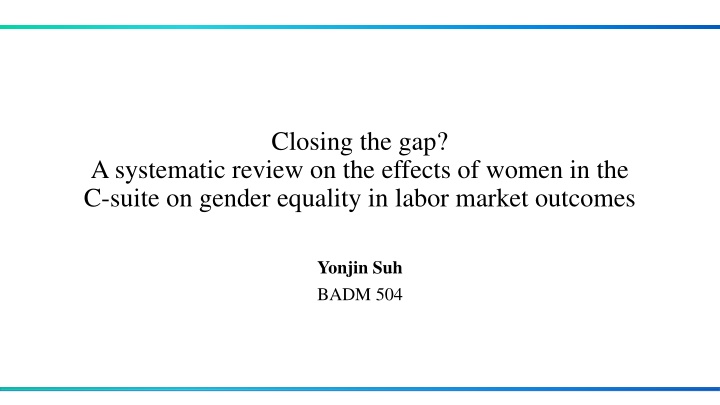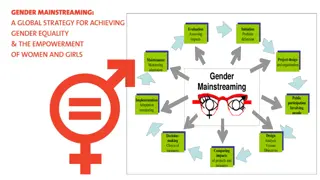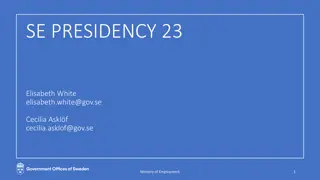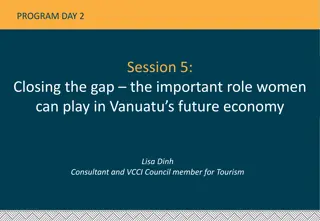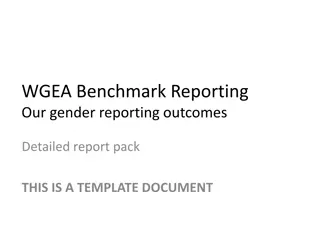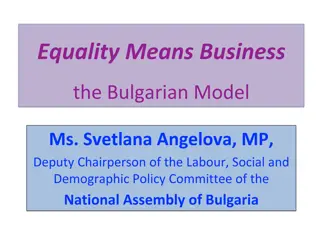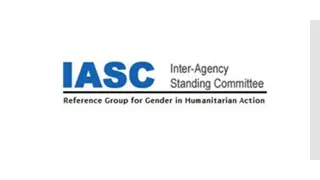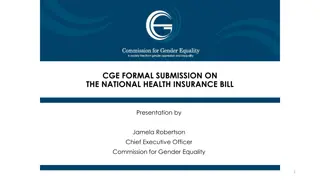Effects of Women in the C-Suite on Labor Market Gender Equality
Increase in women in leadership roles prompts debate on their impact on gender equality in the labor market. A systematic review looks into antecedents, spillover effects, and the influence of women in the C-suite. Research shows mixed results on the significance of their influence, requiring further examination. The topic gains relevance with a growing body of literature, offering theoretical and practical implications.
Download Presentation

Please find below an Image/Link to download the presentation.
The content on the website is provided AS IS for your information and personal use only. It may not be sold, licensed, or shared on other websites without obtaining consent from the author.If you encounter any issues during the download, it is possible that the publisher has removed the file from their server.
You are allowed to download the files provided on this website for personal or commercial use, subject to the condition that they are used lawfully. All files are the property of their respective owners.
The content on the website is provided AS IS for your information and personal use only. It may not be sold, licensed, or shared on other websites without obtaining consent from the author.
E N D
Presentation Transcript
Closing the gap? A systematic review on the effects of women in the C-suite on gender equality in labor market outcomes Yonjin Suh BADM 504
Introduction and Background Increase in interest in DEI practices and outcomes of firms Still significant gender gap in terms of hiring and promotion and compensation (e.g., gender segregation and gender wage/pay gap) Discussion on various antecedents Ongoing debates on the determinants of equality and diversity Increasing focus on whether women help women (positive spillover effects): Cogs of the machine or Change agents? Supporters or Queen bee? Symbolic or Substantive? Inconclusive and Results show that power and status matter Increase in women in the C-suite (board of directors & TMT & CEO) Talk of a female advantage in leadership
Research question Research question: Do women in the c-suite have a significant influence on increasing gender equality in labor market outcomes? Answer: Yes and No and It depends
Relevance of topic for systematic review Upward trend and increasing Progression of publications 18 16 Fractured and scattered 14 12 10 8 6 Tensions and different conclusions 4 2 0 2000-2003 2004-2008 2009-2013 2014-2019 2019-2023 Theoretical and practical implications
Scope, Coverage, and Steps to search process Step 1: Goals & Keywords Goals: - Explore if there are significant effects? Explore if the effects are positive or negative, if there are effects? Identity outcomes as well as potential mediating and moderating factors - Integrate and synthesize fragmented literature to provide novel insights - Critique literature, provide alternative paths for current literature, and propose avenues for future research. Keywords: - Conducted preliminary literature review on relevant topics on google scholar to identify potential keywords Term 1: TMT OR Top mange* OR TOP leader OR Executive OR CEO OR Board OR Director* OR Upper manage* OR Upper echelon*: Senior manage* OR C-suite OR Corporate leader* OR Corporate elite OR Corporate officer OR strategic leader* OR presentation Term 2: AND Female / AND gender / AND Wom?n - Conducted search using the SCOPUS database
Scope, Coverage, and Steps to search process Step 2: Scope - Casted a wide net in terms of inclusivity and then narrow down the search and eliminate irrelevant articles - Sought to be interdisciplinary by taking into consideration studies from disciplinary areas including management, finance, accounting, psychology, sociology, economic - Limited research to those published after the 2000s (before women representation in the C-suite was too low) until 2023 - Set journal list: Consider only journals that are 3 or higher on the CABS journal list for management and business-related journals and 4 or higher for finance and economics and accounting and social science journals (140 potential journals) Inclusion criteria - Inclusion criteria 1: Studies which are articles, published in journals, are written in English, published in the disciplines of business, management & accounting, economics & finance, psychology, social sciences, multidisciplinary, and undefined (just in case) led to 44,050 articles for female, 10,260 articles for Gender, 17,810 articles for wom?m - Inclusion criteria 2: Studies which are published in the CABS journals list that was determined when setting the scope - Led to 983 articles for female, 766 articles for women, and 967 articles for gender - Inclusion criteria 3: Studies which are empirical and conducted in work and organizational contexts and are relevant to management and organizational theories. - Inclusion criteria 4: Studies where the main focus of the article was on women in the C-suite and labor market outcomes
Scope, Coverage, and Steps to search process Step 3: Article selection & Coding of articles Removed duplicates and based on cursory reading of titles and abstracts included only those papers that potentially fit inclusion criteria - Led to 61 potential articles Based on full reading of relevant journals included only those papers that actually fit inclusion criteria - Led to 38 articles Conducted google scholar search for journals that are 4* to check for forthcoming articles - Led to 39 final set of articles Examination of Preliminary Search Results & Extraction of Relevant Content Examination of the final set of identified papers - Examined the identified set of identified articles, paying attention to purpose, hypotheses/propositions, findings, and conclusions. Systematic coding procedure - Focusing on the goals of the review, came up with a systematic coding process that will help us organize and integrate the literature - Coding articles based on IV, DV, type of DV (i.e., whether it is hiring/promotion or wages/pay), moderator, and mediators, and conclusion (positive or negative) - Coded the articles based on theoretical perspectives, by focusing on key theories that were directly invoked when formulating the hypotheses/propositions - Coded the articles based on the methodological approaches, such as whether the study quantitative or qualitative, study design, sample type, scale or measure used, level of analysis, and the country the study was conducted in 38 articles in 22 journals
Descriptive statistics of articles Labor market outcomes examined by studies Specific effects of women in the C-suite Country of sample firms North America South America Europe Asia Representation Pay/wage Both Positive Negative Contingent Africa Oceania Middle east Multi-country
Preliminary descriptive statistics Two-thirds on gender representation at the top and lower management, one thirds on gender wage/pay gap Two-thirds of the articles argue for positive effects and one-third of the articles argue for negative effects Most research conducted in US or European countries (only one in Asia and only two multi-country studies) All use panel and archival data About two-third focused only on main effects (without moderators or mediators), one-third focused on moderators, and only three studies examined mediators Most often used theory is social role theory and critical mass theory
Examination of Variables and Relationships Outcomes: Representation(promotion) at the top, middle and lower levels of management, gender segregation in employment, discrimination in hiring, gender wage/pay gap (R vs P vs Both) Potential direction of relationships: Same level: Board of directors Board of director, CEO/TMT TMT Trickle down effects: Board of directors TMT Trickle up effects: TMT Board of directors, LLMM TMT, Overall TMT & Board Spillover effects from other firms or the overall industry: Corporate Client TMT MMLM, Connected firm or industry average of board of directors Board of directors & TMT Moderators: Critical mass, Time, Regulation, Managerial discretion & Power, Other board characteristics, Female-friendliness of firm, etc. Mediators: Diversity and equality practices, diversity discounts, changes in terms of composition, structure, size and functioning
Three perspectives: Positive vs Negative vs It depends Positive: Social role theory & Social identity theory & Homophily theory & Signaling theory Similarity-attraction hypothesis & Inter-group contact hypothesis & Signaling of quality Negative: Institutional theory & Agency theory & Gender role congruity theory & Social identity theory Queen bee syndrome & Diversity discount/Implicit quota hypothesis & Pursuit of self-interests It depends: Critical mass theory & Upper echelons theory Need numbers & Power & Discretion
Agenda for Future research Research on trickle-down effects to lower levels of management and overall levels of equity and diversity in the organization Research on spillover effects from outside the firm Research on boundary conditions, especially as conclusions are divided Research that actually tests mechanisms Research at multiple levels of analysis Research on cross-country and cross-cultural effects (Does DEI issues not matter yet for developing countries?)
Reference list of journal articles Ali, M., Grabarski, M. K., & Konrad, A. M. (2021). Trickle down and bottom up effects of women's representation in the context of industry gender composition: A panel data investigation. Human Resource Management, 60(4), 559-580. Amore, M. D., & Garofalo, O. (2021). Pay inequality and gender dynamics in top executive positions. Corporate Governance: An International Review, 29(6), 526-540. Beckman, C. M., & Phillips, D. J. (2005). Interorganizational determinants of promotion: Client leadership and the attainment of women attorneys. American Sociological Review, 70(4), 678-701. Biswas, P. K., Chapple, L., Roberts, H., & Stainback, K. (2023). Board gender diversity and women in senior management. Journal of Business Ethics, 182(1), 177-198. Biswas, P. K., Roberts, H., & Stainback, K. (2021). Does women's board representation affect non managerial gender inequality?. Human Resource Management, 60(4), 659-680. Carter, M. E., Franco, F., & Gine, M. (2017). Executive gender pay gaps: The roles of female risk aversion and board representation. Contemporary Accounting Research, 34(2), 1232-1264. Cook, A., & Glass, C. (2014). Women and top leadership positions: Towards an institutional analysis. Gender, Work & Organization, 21(1), 91-103. Cook, A., Ingersoll, A. R., & Glass, C. (2019). Gender gaps at the top: Does board composition affect executive compensation?. Human Relations, 72(8), 1292-1314. Corwin, E. S., Loncarich, H., & Ridge, J. W. (2022). What s it like inside the hive? Managerial discretion drives TMT gender diversity of women-led firms. Journal of Management, 48(4), 1003-1034. De Cabo, R. M., Gimeno, R., & Escot, L. (2011). Disentangling discrimination on Spanish boards of directors. Corporate Governance: An International Review, 19(1), 77-95. Dezs , C. L., Li, Y., & Ross, D. G. (2022). Female CEOs and the compensation of other top managers. Journal of Applied Psychology. Dezs , C. L., Ross, D. G., & Uribe, J. (2016). Is there an implicit quota on women in top management? A large sample statistical analysis. Strategic Management Journal, 37(1), 98-115. Dwivedi, P., & Paolella, L. (2023). Tick-Off the Gender Diversity Box: Examining the Cross-Level Effects of Women's Representation in Senior Management. Academy of Management Journal, Forthcoming. Elvira, M. M., & Cohen, L. E. (2001). Location matters: A cross-level analysis of the effects of organizational sex composition on turnover. Academy of Management Journal, 44(3), 591-605. Farrell, K. A., & Hersch, P. L. (2005). Additions to corporate boards: The effect of gender. Journal of Corporate finance, 11(1-2), 85-106. Flabbi, L., Macis, M., Moro, A., & Schivardi, F. (2019). Do female executives make a difference? The impact of female leadership on gender gaps and firm performance. The Economic Journal, 129(622), 2390-2423. Geiler, P., & Renneboog, L. (2015). Are female top managers really paid less?. Journal of Corporate Finance, 35, 345-369. Glass, C., & Cook, A. (2018). Do women leaders promote positive change? Analyzing the effect of gender on business practices and diversity initiatives. Human Resource Management, 57(4), 823-837.
Reference list of journal articles Gould, J. A., Kulik, C. T., & Sardeshmukh, S. R. (2018). Trickle down effect: The impact of female board members on executive gender diversity. Human Resource Management, 57(4), 931-945. Guldiken, O., Mallon, M. R., Fainshmidt, S., Judge, W. Q., & Clark, C. E. (2019). Beyond tokenism: How strategic leaders influence more meaningful gender diversity on boards of directors. Strategic Management Journal, 40(12), 2024-2046. Guo, X., Gupta, V. K., Mortal, S., & Nanda, V. Gender and Managerial Job Mobility: Career Prospects for Executives Displaced by Acquisitions. Journal of Financial and Quantitative Analysis, 1-79. Hillman, A. J., Shropshire, C., & Cannella Jr, A. A. (2007). Organizational predictors of women on corporate boards. Academy of management journal, 50(4), 941-952. Huang, J., Diehl, M. R., & Paterlini, S. (2020). The influence of corporate elites on women on supervisory boards: Female directors inclusion in Germany. Journal of Business Ethics, 165, 347-364. Knippen, J. M., Shen, W., & Zhu, Q. (2019). Limited progress? The effect of external pressure for board gender diversity on the increase of female directors. Strategic Management Journal, 40(7), 1123-1150. Kunze, A., & Miller, A. R. (2017). Women helping women? Evidence from private sector data on workplace hierarchies. Review of Economics and Statistics, 99(5), 769-775. Lucas-P rez, M. E., M nguez-Vera, A., Baixauli-Soler, J. S., Mart n-Ugedo, J. F., & S nchez-Mar n, G. (2015). Women on the board and managers pay: Evidence from Spain. Journal of Business Ethics, 129, 265-280. Maida, A., & Weber, A. (2022). Female leadership and gender gap within firms: Evidence from an Italian board reform. Ilr Review, 75(2), 488-515. Matsa, D. A., & Miller, A. R. (2011). Chipping away at the glass ceiling: Gender spillovers in corporate leadership. American Economic Review, 101(3), 635-639. Mendiratta, E. (2021). Illusion of Inclusion: Examining Trickle-Down Effects of the Board Gender Quota Regulation in India. Gender & Society, 08912432231195070. Ng, E. S., & Sears, G. J. (2017). The glass ceiling in context: the influence of CEO gender, recruitment practices and firm internationalisation on the representation of women in management. Human Resource Management Journal, 27(1), 133-151. Page, A., Sealy, R., Parker, A., & Hauser, O. (2023). Regulation and the trickle-down effect of women in leadership roles. The Leadership Quarterly, 101721. Perryman, A. A., Fernando, G. D., & Tripathy, A. (2016). Do gender differences persist? An examination of gender diversity on firm performance, risk, and executive compensation. Journal of Business Research, 69(2), 579-586. Schoonjans, E., Hottenrott, H., & Buchwald, A. (2023). Welcome on board? Appointment dynamics of women as directors. Journal of Business Ethics, 1-29. Smith, N., & Parrotta, P. (2018). Why so few women on boards of directors? Empirical evidence from Danish companies in 1998 2010. Journal of Business Ethics, 147, 445-467. Stainback, K., Kleiner, S., & Skaggs, S. (2016). Women in power: Undoing or redoing the gendered organization?. Gender & Society, 30(1), 109-135. Terjesen, S., & Singh, V. (2008). Female presence on corporate boards: A multi-country study of environmental context. Journal of business ethics, 83, 55-63. Tinsley, C. H., Wade, J. B., Main, B. G., & O Reilly, C. A. (2017). Gender diversity on US corporate boards: Are we running in place?. ILR Review, 70(1), 160-189. Wang, M., & Kelan, E. (2013). The gender quota and female leadership: Effects of the Norwegian gender quota on board chairs and CEOs. Journal of business ethics, 117, 449-466. You, J. (2021). Beyond twokenism : Organizational factors enabling female directors to affect the appointment of a female CEO. Strategic Organization, 19(3), 353-383.
